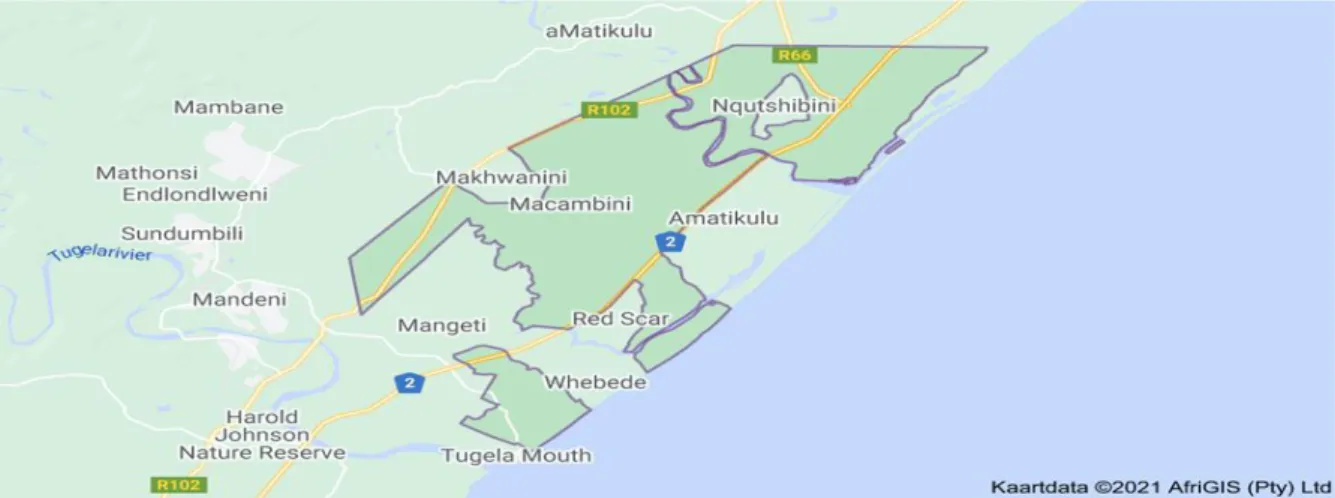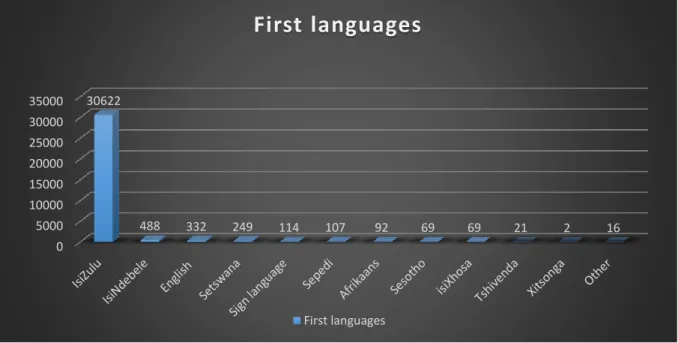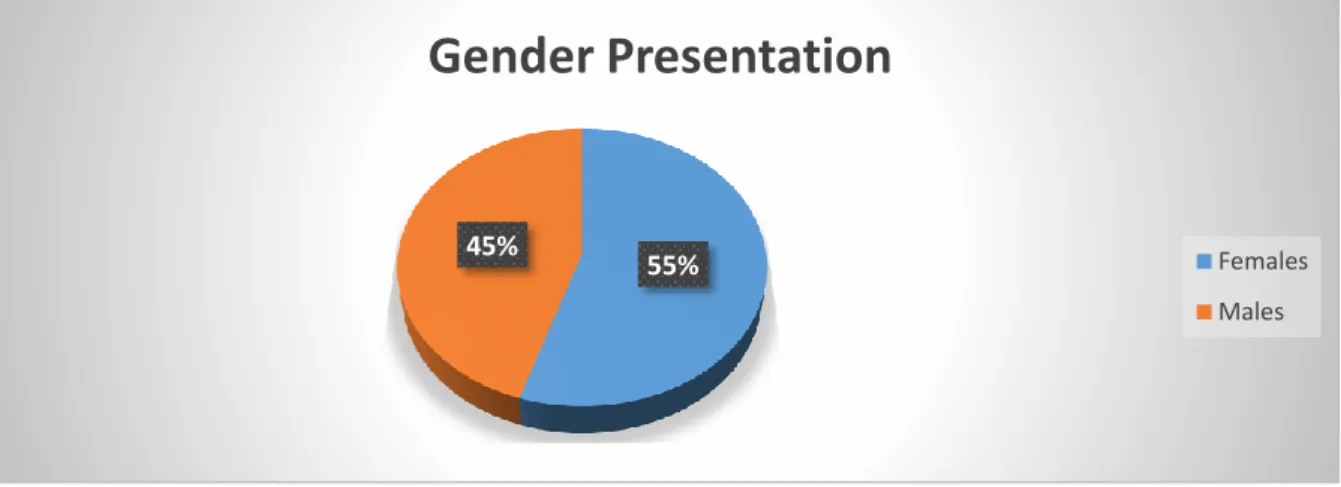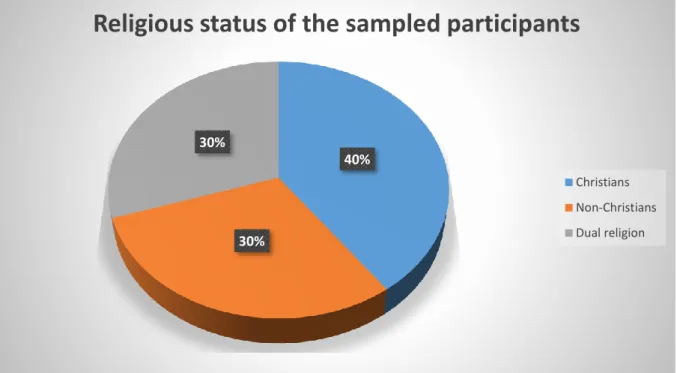This thesis anthropologically and qualitatively explored the death, religion and cultural schemas of the eMacambini community during the COVID-19 alert level 5. Age range of the sampled participants - bar graph Figure 5.3 Religious status of the sampled participants.
Introduction
This chapter first provides a background to this study, inspired by a strong concern about the disruption that COVID-19 has caused in the lives and cultural experience of ordinary people of the Macambini community with regard to funeral rites and the sending of their loved ones to in the middle of this pandemic. To this end, this chapter will serve to explain the background of the research, the motivation of the research, the problem definition, the research questions, the objectives, the main theories on which this research is based, a brief outline of the methodology and methods, the significance of the study , and finally, the plan and structure of the thesis.
Background of the study and Problem statement
In the words of Omonisi (2020), COVID-19 seemed mostly to go against cultural schemas that Africans followed when death has claimed a family member. In the context of the COVID-19 pandemic, there are several factors that made it difficult for families and households to grieve.
The relevance of the problem statement in an Anthropological context
The report's information also suggested the many obstacles that families faced in the global context of the first wave of COVID-19 in observing the traditional period of grieving the loss of loved ones, and therefore it is important to study different cultural experiences . Family members of the deceased were banned from preparing "decent" funerals for their loved ones and from performing customary funeral rites.
Rationale and the significance of the study in anthropology
To increase the amount of knowledge that could help future generations, it is important to understand all aspects of the social system and every natural phenomenon that affects the existence and organizational structure of society. The research findings will contribute to the existing body of knowledge that seeks to find practical solutions to the consequences caused by COVID-19 in the province of KwaZulu-Natal.
Research Objectives
To understand the impact of the COVID-19 pandemic on death, religion and cultural schemas in indigenous communities in South Africa regarding funeral rituals and mourning performances. To find out whether the World Health Organization (WHO) COVID-19 protocols imply a hegemonic imposition on African indigenous communities from the viewpoints of families and households, including traditional leaders.
Research questions
Do COVID-19 protocols imply a hegemonic imposition of African societies based on the views of traditional leaders and supporters? How have Africa's 'culturally rooted' societies culturally adapted to the announced restrictions due to the COVID-19 pandemic?
Research site
INkosi Ubaba Mthokozisi Mathaba, the son of the late iNkosi Khayelihle Mathaba is primary custodian and the leader of eMacambi community. From the graph above, the Macambini community is dominated by about 99.56% of Black African people and the 0.44% is made up of Coloureds, Indians, Whites and others.
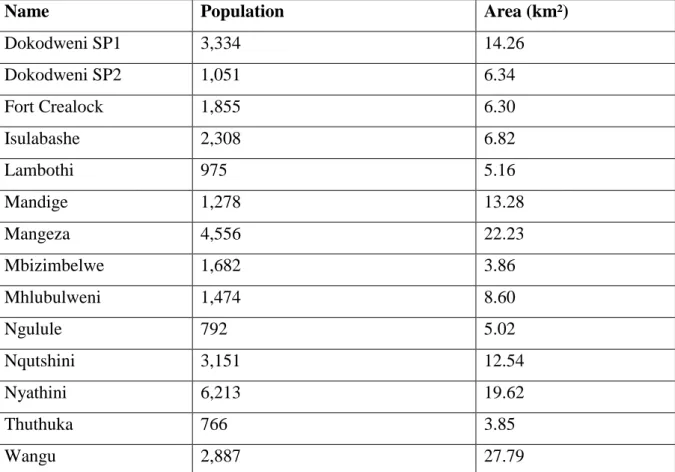
Definition of keywords
Cultural Schema- Boutyline & Soter (2020) define cultural schemas as the central cognitive mechanism through which culture influences every action. Prameswari, Hibino & Koyama (2017) define cultural schemas as a culture down to the cognitive level, which provides a reference to knowledge while also shaping perspectives (Prameswari et al., 2017).
Brief introduction of the theoretical framework and the research methodology
Social Construction Theory
They further hinted by saying that cultural schemas are socially shared heuristic representation that can be deployed in automatic cognition (Boutyline & Soter, 2020). This theory shaped the qualitative research design of the study and the wording of research objectives that allow for reflexivity.
Cultural relativism
This will enable the sample population to reflect or narrate how they have been socialized as members of families and households; how these families and households perform rituals of death, religion and other schemas that imply indigenous knowledge systems and translate their symbolic identity. The cultural relativism of Boas denied the idea of the German philosopher Lucien Levy-Bruhl, who claimed that "the primitive mind was "pre-logical" and did not meet the requirement for scientific and rational thought" (Eriksen, 2017).
Research methodology And Design
Research Paradigm
This theory uses an emic perspective of people from families and households of the eMacambini community to narrate the cultural schemas and mourning rituals in the wider context and enables participants to contribute an emic perspective (without judging become) of their learned cultural schemas, as the Social Construction theory asserts. The Social Constructivism Theory and Cultural Relativism will enable the participants to give an emic perspective (without being judged) of their learned cultural schemas as the Social Construction Theory claims.
Study layout
Chapter Summary
Introduction
Literature review data sources
Conceptualization of death in anthropology
Conceptualization of Culture and religion in an anthropological context
- Culture
- Religion
According to Radzilani (2010), culture is defined as the socially transmitted behavioral patterns, philosophical beliefs and artistic creations of a specific population, community or group of people. Religion, according to Radzilani (2010), is the system of believing in and worshiping a supernatural power or God.
Anthropology, Culture and Death
- Death across all cultures
The latter may see death as the end of life rather than a process involving ancestors and perhaps God. Radzilani (2010) considers the concept of ancestors as the rebirth of death in the spiritual world.
Social conceptualization of death and dying in an African context
- Good death
- Wild death
- Causes of death
According to Nobles (2006), who was cited by Baloyi and Makobe-Rabothata (2014), death is an additional developmental milestone for indigenous African people, apart from other life stages and developmental processes. According to him (Owino, 2017), anything that disrupted the ontological path of life and brought sickness and early death is/are thought to be the result of witchcraft or demonic spirits.
Bereavements, grief, mourning, burials, and rituals
- Bereavements
- Coping with death to the bereaved- Death as a family and a community event
Death is considered a permanent loss of life, as Pelewe (2018) termed it as an elimination from the world of the living. Death is the painful and stressful anxiety event; it is seen as heartbreaking and a threat to the well-being of the bereaved.
Culture burials and rituals
Family members are believed to have an emotional bond and are sensitive to each other's needs, wants, concerns and distress. They believe that in order to transition into a new role, survivors must relinquish the key function they played and the status they shared with the deceased.
The meaning and impact of rituals from the African perspective
These include notifying the public of the passing, visiting the body, selecting a casket and headstone, and holding a pre-funeral prayer service (Pang & Lam, 2002; Selepe & Edwards, 2008). The chance to reach out or request assistance is offered by the public notice or announcement of death and the pre-burial prayer (Bolton & Camp, 1987; Selepe & . Edwards, 2008).
Functions of rituals
As a result, people engage in mourning rituals to help or allow the deceased to enter the world of the ancestors. The dead must enter the world of the ancestors and assume responsibilities that the living consider ancestral.
The history of pandemic outbreaks and their Impact in Africa and African Societies
Mortuary and funeral rites are used to mark the last stage of the life cycle, and they are the most important, according to the findings of (Adom, et al., 2021). According to Adom, et al. 2021), correct burial procedures and rites are thought to prevent the spontaneous death of a family member or community member by the spirit of the deceased, which may be vengeful if cultural protocols for funeral or burial ceremonies are violated.
National Shutdown and lock downs restrictions
According to Da Silva et al. 2020), the absence of rituals could lead the spirit of the deceased to take revenge on the living, in addition to making it difficult for those who have lost a loved one to mentally realize their loss. With funeral directors and relatives unable to perform conventional funeral and funeral procedures, the grieving process was incomplete and the family feared that the world of the living dead would descend into chaos.
Funerals, rituals under strict restrictions
Traditionally, the body was delivered the day before the funeral so that the mourners could gather at the family home. In keeping with African tradition, the family visited the morgue and washed the body to identify the correct body before even placing it in a coffin.
Chapter Summary
- Introduction
- The importance of a theoretical framework
- Social Constructivism theory
- Historical background of the theory
- The relevancy of Social Constructivism Theory in this study
- Cultural Relativism
- Historical background of the theory
- The relevancy of Cultural Relativism theory in this study
- The connection between theoretical framework and ontology and epistemology
- Ontology
- Epistemology
- The philosophical standpoint of these two theoretical frameworks
- Chapter Summary
With interpretivism, this study evaluates the nature of the research subject knowledge and its relationship with the researcher (Huberman and Miles, 2002). 3The term "metaphysics" refers to the study of the absolute nature of objects beyond their physical manifestation (Rawnsley, 1998; Tsagdis, 2002).
- Introduction
- Research type and method
- Research design and Paradigms
- Research Paradigm
- Data collection methods
- Primary data sources
- Ethnography
- Data collection instrument
- Semi-structured interviews
- Sampling
- Sample design
- Non-probability Sampling
- Sample size
- Inclusion and exclusion
- Validity and reliability
- Ethical considerations in the study
- Discussion of Ethical considerations and gatekeeper clearance
- Data collection experience
- Data processing and analysis
- Familiarization with data - Listening and registering all collected data from one-
- Reviewing themes and linking them to existing literature reviews
- Defining and naming themes
- Producing the report or Manuscripts
- Chapter summary
Purposive snowball non-probability sampling techniques were used by the researcher's choice in this study. According to Braun and Clarke (2006), during this stage the researcher decides which features of the data capture each topic and decides what interests them and why.
DATA PRESENTATION AND INTERPRETATION/ANALYSIS INTRODUCTION
EMERGED THEMES FROM DATA ANALYSIS
- THEME ONE
- THEME TWO
- THEME 3
- THEME 4
- THEME 5
- THEME 6
- THEME 7
CHAPTER SUMMARY
Introduction
The purpose of this chapter is to summarize and contextualize the data presented and analyzed in chapter five to establish the findings of this study. This chapter discusses the data presented in chapter five with the aim of interpreting and questioning the data presented so that the principal investigator can determine the opposing findings of the study.
Discussions and Summary of the findings
Findings showed that the COVID-19 pandemic had a huge impact on all crucial cultural practices, including funerals and burials across all Indigenous societies in the e-Macambini community. This survey found that e-Macambini people felt excluded from all means of responding to COVID-19.
Contributions
89 The body of the deceased was taken from the mortuary directly to the cemetery without being brought home for all African and religious burial rites to be observed. In order for all cultural and religious ceremonies to be thoroughly fulfilled, the body of the deceased arrives at the family's house the day before, and remains there for the night vigil and burial.
Recommendations
This study, taking the point of view of the culturally rooted African Indigenous societies, questions the WHO's call for restrictions (2020) and raised many challenges not previously documented, which will be integrated into the existing cultural text in anthropology. Based on the findings of this study, it is recommended that government officials and authorities consult the public, including traditional leadership, before passing and enforcing legislation that will undermine socially constructed cultural and religious schemes and traditions.
Limitations
This must be done with the mentality that says: "to find solutions to African problems, African people must be consulted to provide efficient and effective African methods to provide solutions".
Chapter summary
This proposed study is a critical analysis of the integration of cultural and religious perspectives of indigenous communities during the COVID-19 pandemic. Have you lost or buried a loved one amid the level 5 national lockdown of the COVID-19 pandemic.
